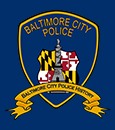1900 - 1920

1900 - 1920

The Last Marshal of Baltimore
Robert Dudley Carter, was born in Littleton, Halifax County, North Carolina, 1852. He was the son of Jesse and Sallie Ann Carter (Whitaker). Robert got his middle name after the first elected Governor, "Edward Bishop Dudley" elected by the people of North Carolina 1835. Robert worked on his family farm and as a teamster wagon driver. In 1869, Robert served in the U.S. Navy for 4 years; he married Dona Burkhart his wife, in 1875 at the age of 23. Robert had moved to Baltimore in 1875, Dona gave birth to a daughter, "Bessie May Carter" she was born in Baltimore. Robert was working in Baltimore as a Teamster with the old-horse-car service, after which he was a contracting foreman. In 1878 Dona gave birth to a son "Robert Dudley Carter Jr."; he also was born in Baltimore. He bought his first house in 1880, at 1650 North Gilmore Street. 1884 May 12, Robert received an appointment to (Police Officer), North West District, Baltimore City, he was 32 years old. He work hard at being the best, and in 1888 March 9, he was promoted to Sergeant and 1892 November 17 to Lieutenant. In this same year Robert D. Jr. and Bessie May and her husband were living with Robert and Dona at 1650 North Gilmore Street. 1894 April, Robert's father Jesse, was visiting from Sterms, Granville County, North Carolina and pass-away in bed at Robert's house 1650 North Gilmor St. Baltimore. Dr. George W. Norris was called in and said his death was due to heart disease. Jesse was 73, and was a merchant, in Dry Goods, Stems, and Halifax counties North Carolina. Jesse's body was sent home to North Carolina. Working long days most up to 18 hours, showed Robert as a good Policeman, by 1914 August 14, Robert was promoted to" Marshal of Baltimore City Police Department", he skipped the rank of Captain, he was 62 years old. May 27 1915, there was a 63rd birthday party held at "Arion's Country Club", Wilkens Avenue extended. It was expected to be up to 800 citizens of Baltimore who have become acquainted with Marshal Carter. He was given a "14-karat Solid Gold Badge", with 63 diamonds set in platinum. Topping the American eagle is a one-karat diamond. In 1917 Marshal Carter was elected to the National Commander of the Army and Navy Union at the eighteenth biennial encampment at the Bohemian Hall, on Gay and Preston streets. September 4, 1918 he was the Chief marshal of the parade headed by a delegation of the Grand Army of the Republic, and several thousand United Spanish War Veterans who are holding their twentieth encampment. 1920 was a hard year for Robert, Dona was ill, Robert D. Jr. was ill also. Robert Jr. was in a sanatorium in the mountains, Marshal Carter had Mary Gohagen working for him to help take care of Dona and Robert Jr. Marshal Carter brought Robert Jr. home from the sanatorium knowing that he could live only a short time. December 26, 1920 Robert Jr. pass away at the age of 42, when Dona was told she became unconscious. In 1921 August 7, Dona had passed away, this same year Marshal Carter retired form the Baltimore City Police Department on January 20, 1921 with (36) years (8) months of service at age 68. Marshal Carter moved in with his daughter Bessie and his son-in-law Henry D. Hammond at 604 Hollen Road, Baltimore where he lived until 1936 October 22 when he passed away from pneumonia at the age of 84. The Rev. Bruce H. McDonald, pastor of the Westminster Presbyterian Church, conducted the services. The Burial was in Woodlawn Cemetery, Baltimore County, with his wife Dona and son Robert D. Jr. with wife Effie, and Robert D. Sr., daughter Bessie Carter Hammond. The Baltimore City Police Department named in his honor the "Police Boat" after Robert D. Carter. Marshal Robert D. Carter was the "Last Marshal of Baltimore City Police 1921. When General Gaither, Commissioner of Police, took office late in 1920, he started a reorganization of the department, and when Marshal Carter retired he created the post of Chief Inspector. Marshal Carter, with tears filled his eyes, he stated he did not expect the recognition given him, as he felt he was appointed to the position of Marshal of police by the Police Board and not by the citizens, "but I am happy to say", he remarked, "that the Police Department and every citizen of Baltimore will get the best in me and in the force under me. I feel that Baltimore has the best Police Department in the country. Marshal Carter is personal known to police chiefs across the country. He is a close personal friend of "William A. Pinkerton", the noted Private Detective. Robert was a Thirty-second degree Mason, Shriner, and Knight Templar.
By great grand nephew
Kenneth M. Carter


COURTESY OFFICER JAMES McCARTIN
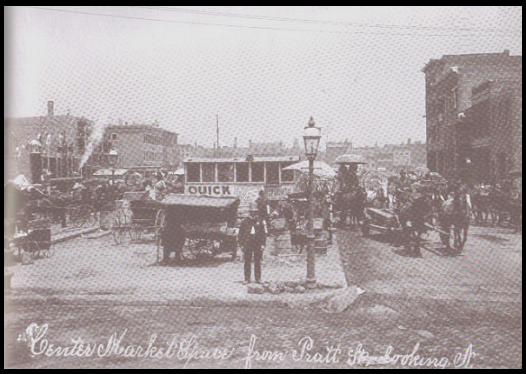
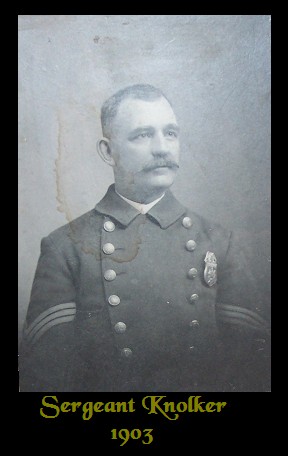
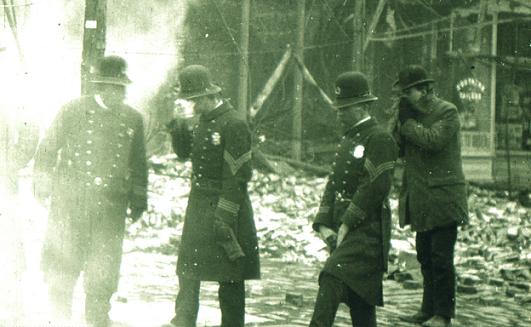
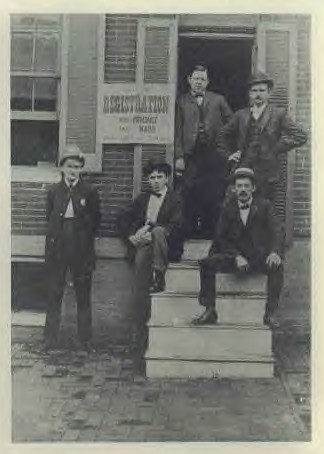
1904 Presidential Election Judges John Ruddy, Arthur Ningard, Arthur Ford, James Scott. This photo, depicts the Judges of Election in the Twelfth Precinct (Locust Point, Baltimore City) during the 1904 presidential campaign. Teddy Roosevelt was elected. Pictured here are John Ruddy (top left), Arthur C. Ningard (top right), Arthur Ford (bottom left policeman) and James W. Scott (bottom right). The fifth man is unknown.

"Beauty Squad"
In some of the officer's hands, it appears that they are holding swords, those are actually sticks, a sort of swagger stick, that was used to direct traffic, in a squad of well-dressed, well-groomed men, that wore white parade gloves year round. There were complaints about the gloves, but the no one listened, they said the gloves were part of the uniform, and will continue to be worn. That is downtown, the further west the squad went the more laxed the rules were.
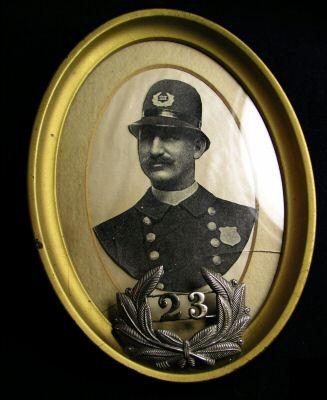

W.J. Bateman, Baltimore Police Officer 1907, great-grandfather of Ron Bateman, the current AA County, Maryland Sheriff and a retired Captain from AA County Police Dept.
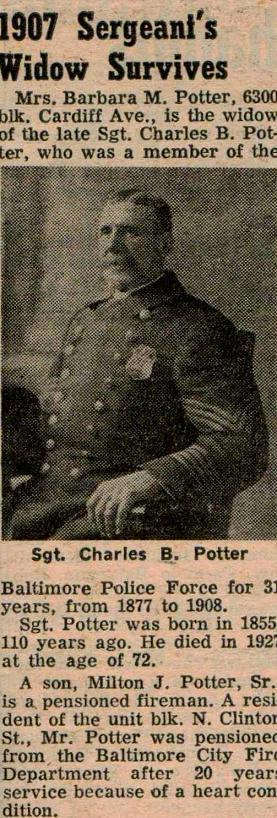
Fireworks in America - Fireworks in Baltimore
Americans have been setting off fireworks to celebrate our independence since 1777, Baltimore City was one of the first Cities to illegalize the use of consumer fireworks. The first year of these rules came about was 1904 when we saw improvements in reduced injuries immediately. While surrounding counties the same year with relaxed firework laws, say death and dismemberment in 1904 with two young men each losing a hand to fireworks.
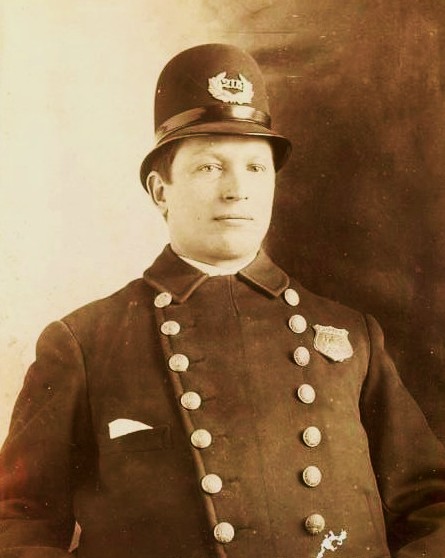 Photo courtesy Nancy Cook
Photo courtesy Nancy Cook
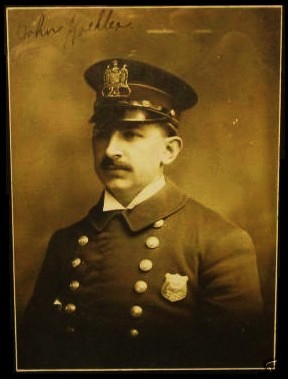



21 July 1909
To Keep Tabs on Pawnshops
Col. Swann Once Law Regarding Daily Reports of Deals
To help the police keep tabs on secondhand dealers and pawnbrokers who by stolen goods, Col. Sherlock Swann, President of the Board of Police Commissioners, will have introduced into the next Legislature a bill compelling Three-Ball Experts to make daily reports to the police Headquarters their purchases of valuables. Laws like this are in existence in nearly every other city.
“It is very important,” said Col. Swann yesterday, “that we have such a law in Baltimore. I do not say this simply because other cities have it, but only because it is necessary to keep tabs on stolen articles.
"I hope that when the bill is introduced at the coming Legislature it will pass, for it will be of great help to our department. Such a law affords the police the opportunity to recover the stolen property if the thieves are not caught. “Marshall Farnan warmly approved of the idea. "It's a necessity," said the Marshal. "To do good work we have to be able to date, and we should, by all means, have a system of knowing what jewelry is bought by secondhand dealers and pawnbrokers."


 Retired Marshal Jacob Frey Buried
Retired Marshal Jacob Frey Buried
Notable men attend the funeral of Former Police Chief
The Sun Jan 5, 1911
With his bier surrounded by veteran policemen who admired him in life for his ability and courage, the funeral of ex-marshal Jacob Frey, who Died Sunday night, took place at 2 o'clock yesterday afternoon from his home 510 N Carey St. The service conducted by Rev Harry D Mitchell, Pastor Harlem Methodist Episcopal Church, brought tears not only to the eyes of the veteran Police, and Family, but also to the several members of the old Lobby Club, which met several years ago at Ford's Theater Opera House.
The pallbearers were Messrs Emerson Loudenslager, Frank Reynolds, Rodger Reynolds, Jacob Frey, George Frey, and Roger Frey, grandsons and nephews of Marshal Frey. Burial was in Greenmount Cemetery. The parlor was beautiful floral tributes sent by friends and by policemen from all 9 districts.
three bank president - Mr. Donald H Thomas, Mr. Thornton Rollins, and Mr. Jacob Hook - all of whom were closely associated with Mr. Frey in life and who were members of the lobby club, were present Marshal Farnan, with all district captains in uniform, also attended and when the body was carried to the hearse from the house, they formed a guard on the pavement.
At the grave, Mr. Mitchell paid a glowing eulogy to Mr. Frey. Besides Marshal Farnan and Messrs. Thomas, Rollins and Hook the following were present:
Deputy Marshal Manning, Johns Swikert, secretary to Marshal Farnan, Josiah A. Kinsey, secretary to the police board, Captains League, McGee, Santry, Cole, Morheiser, Henry, Moxley, and Gottings, Serge, Edward Shultz, Retired Capts. Cadwalder and Gilbert and Retired officers P H Stewart, Augustus Reinhardt, W J Fairbanks, William Wallace, William Pearson, and Andrew J Saucer. Messrs, Robert Fusselbough and William J Murray Police inspector Andrew Houghton of Boston also attended
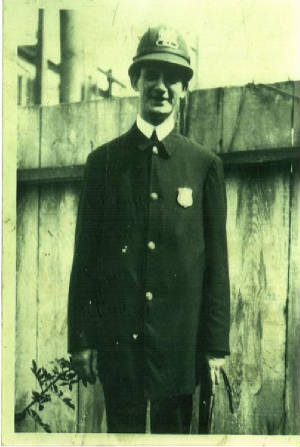

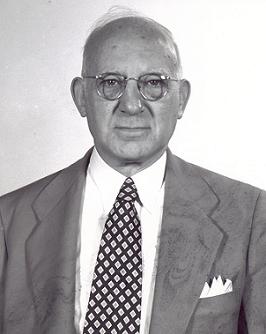


5 July 1909
‘Twas a Quiet Fourth
Young America Dared Not Defy Strict Orders of Police
Many Spent the Day in Country
Celebrations Planned for Today Marshall Says, He Will Enforce Law to The Letter
Young America in and about town been the supply and need yesterday to the law. There was few shattering’s of the atmosphere by noisy crackers or dynamite caps and the day was one of the quietest fourth of July’s this city has seen. This may have been because the day was Sunday. But if Marshall Farnan’s police force can enforce the law today there will be a little loud celebration.
Public opinion has demanded a “bloodless” fourth, and while there may have been several policemen “willing to wink there I to let a lad throw a cannon cracker under a horse in the street, they feared to use do so because Marshall Farnan, accompanied by deputy Marshal Manning and Marshall’s secretary’s Swikert, drove around the city in the morning and afternoon.
Stop it the ban was placed on the following explosives: shooting crackers, cannon crackers, Roman candles, skyrockets, pinwheels, split devils, dynamite caps and kindred noisemakers. Occasionally the boom of a cracker or the pop of the torpedo was heard, but the warnings by the police cause parents to watch their offspring’ movements.
Few dealers in the city directly sold any explosives, as they were warned that they would be subjected to heavy panel these if they violated the law. Across the city line, however, the ores are stocked with all sorts of explosives.
Marshall Farnan was highly pleased with the quietness of the day.
“I am as patriotic as anyone in the country.” He said, “I believe in celebrating days of achievement in the proper manner. The use of fireworks of an explosive nature is a means to the community and I hold myself responsible for the lives and property.
“Go to the country – to the parks and resorts. Take your lunches and enjoy yourselves romping on the grass and reading in the cool and shade of the trees. It should be observed like any other holiday – not by making noise, setting fires to valuable property and injuring and killing a large percentage of the populace. Do you call that a proper means of celebrating?
“Every department in this country has followed our idea of having a strict observance of the Fourth of July. We have lessened this toll formerly cause. People feel better, save money and enjoy the day just as well.”
Thousands of Baltimoreans left the city for the suburbs, where many of them will stay until tonight and celebrate the day. The many other resorts that cluster around Baltimore also had therefore quota. At most of these places, there will be a display of fireworks tonight.
Suspicions that the real fourth is at hand were awakened at night by the ascent of some hundreds of balloons from the city, the small boy being unable to restrain his enthusiasm till this morning and uncorked his patriotism at sundown. So, too, did many a paterfamilias surreptitiously send up a hot air bag from the backyard for the delight of the children and his own intense satisfaction. In many of the streets, youngsters gathered an inflated their very colored balloons, which sailed slowly up to incalculable altitudes. Like stars, they twinkled in the heavens, and the elasticity of the human vertebrae was demonstrated as hundreds of heads were bent back in an effort to follow the messengers of independence.
The day was celebrated by the Mecca beans at their country home at Brightside. A specially arranged program was carried out, including the raising of the flag and a salute, a patriotic address, national songs, a concert, military drill, basketball, and dancing.


The Sun (1837-1989);
Policemen, Fat and Thin, Balk At
Suggestions For Comfort.
MARSHALL FARNAN SWATS PLAN
Modest Apollo’s, weary of displaying formless, sidestep proposals for a shirtwaist forced
Police official do not seem to take kindly to the suggestion of a “shirtwaist” form in hot weather. The idea has been advanced that lighter clothing would increase the comfort and efficiency of the men as it was done with letter carriers.
Marshall Farnan would be perfectly willing to have the men wear shirtwaist if it were practicable, but he says he doesn’t think it will be.
“In the first place,” said the Marshal, “they wouldn’t have any place to put their pistols. A policeman carries his gun in a holster (in his pocket) under his coat where he can get to it quickly. If he had to wear a shirtwaist he would have to carry it in his back pocket, and probably but in the pocket even at that, it would attract attention and be hard to get out quickly if he needed it. “Of course, a policeman doesn’t often need his gun, but when he does wanted he wants it badly and he wants a quick. That’s the main reason against shirtwaist’s.
In rainstorms and tussles
“Then if he got caught in a rainstorm and had his shirtwaist soaked, he would be a rather forlorn looking site until he changed it. A man can’t keep a couple of shirtwaist handy, so as to put them on when he gets wet. A coat doesn’t look so bad when it gets wet.
“And then there’s another thing. When a policeman starts to arrest some fellows he often has to wrestle with his prisoner and it would be easy to have a shirtwaist ripped off. Some of the men even get their coats torn. A policeman with a ripple shirtwaist would be like a fellow coming home in a barrel. “The close the men wear in the summer has been chosen because of its lightweight. You could almost see through the stuff, but it wears well and it’s economical.” “How would you like to wear a shirtwaist?” He was asked. “Well,” he mused, “I don’t know. I’m so used to wearing a coat that I guess if I went out in a shirtwaist I take a side street, so that no policeman would see me and arrest me for not having enough close on. I’m not built for shirtwaist, anyway.”
Views of Stout and Thin
One of the Stout policeman was asked what he thought of the plan. “Say,” he puffed, wiping his steaming face, “I’m hot now, all right, but if I had to wear one of those things and have fresh guys coming along every few minutes yelling, “peak – a – Bill,” I guess I’d be hotter still. I’m right touchy about my shape. Somebody would come along and say, “get a V shape, officer, get a V-shaped –“ and I guess I’d have a sweet time explaining to the police magistrate that I had run a fellow in for disorderly conduct.” One of the thin ones was asked if he would like to wear a shirtwaist. “Say,” he replied, “what would I look like, standing at the corner of Charles and Baltimore streets at 2 o’clock of an afternoon with a shirtwaist on and no suspenders. I’m thin; can’t you see that? And my suspenders do real work. No, sir re-, none of these shirtwaist for mine. Let the letter carriers wear them – nobody loves them.”

 COURTESY OFFICER JAMES McCARTIN
COURTESY OFFICER JAMES McCARTIN
Baltimore Police Marshal Robert D. Carter
1914-1921
The last Marshal of Baltimore City
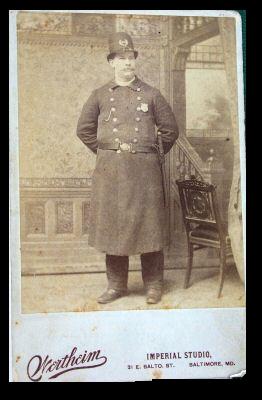
Overdue Honor Paid Officer Slain In 1915
By Donald K. Miller 1944
An error 29 years old in the Police Department records was rectified today when Commissioner Hamilton R. Atkinson ordered the name of Patrolman George C. Sauer inscribed on the role of honor beside those of 22 other policemen who met a violent death in the performance of their duties. Patrolman Sauer was fatally shot in the abdomen shortly after 4 o'clock on the morning of April 9, 1915, by one of three out-of-town. gunmen whom he had chased up a blind alley that runs between Hare Street and Ellwood Avenue. Omission A Mystery Accounts of the killing and of the subsequent roundup of the criminals and their trial in Criminal Court occupied prominent space in the newspapers for many weeks. No one now connected with the Police Department is able to explain the omission all these years of the slain patrolman's name from the Honor Roll. Had not Lieutenant George Sauer, a Central District policeman and son of the slain officer read a recent article in The Evening Sun which listed names on the Police Department's role of honor, more years could have elapsed before the award. My father was a policeman killed in the line of duty. Why wasn't his name mentioned with the others?" the Lieutenant asked. Old-Timers Remember When he was told that police records. dating back to 1870 contained no data on his father's death, the matter was brought to the attention of Commissioner Atkinson. A canvass of the police force unearthed a handful of old-timers who recall the slaying of Officer Sauer. One was Capt. Lawrence King, Commander of the Southwestern District, who at the time was a Detective Lieutenant and one of the Policemen who came to the aid of the stricken officer. As Capt. king recalled, the tragedy followed by three gunmen from a saloon on eight street near Lombard, because of disorderly conduct. Gunmen Open Fire the gangsters, who had been given the bums rush by other patrons of the saloon, whipped out their guns and started blazing away. As they ran down the street pursued by a crowd of infuriated civilians patrolman Sauer joined the chase. Sauer was chasing one of the men up a blind alley when felled by a bullet. Before the assailant had time to escape, he was collared by King. Later in the day, the two other men, identified as companions of the captured gunmen were arrested in their hotel in the unit block of North Liberty Street. The loaded revolvers were found under the pillow of their bed. Two Sentenced to Prison Records of the Maryland Penitentiary disclose that David Bender, of Brooklyn, NY and Harry McQuade, of Philadelphia., were convicted of second-degree murder in connection with Patrolman Sauers death and given 18-year terms in the prison. Bender escaped over the wall of the penitentiary on June 27, 1921, but was later arrested in California on September 20th. On November 16 of the same year, after escaping from the institution, he was sentenced to two more years. Bender was paroled on May 19, 1931, and McQuade was granted a parole on March 25, 1930.


ARE NOW CITY POLICE
The Sun (1837-1987); Jan 6, 1919;
pg. 6
ARE NOW CITY POLICE
33 Former Members of County Department Accepted By City
WERE ASSIGNED YESTERDAY (5 January 1919)
Many of Them Will Patrol Their Old Post in the Newly Annexed Territory
Marshal Carter announced last night That 33 former Baltimore county policemen had been accepted during the past week as members of the city department; had received their uniforms and equipment, and, were attached yesterday to six of the outlying districts and assigned to posts mapped out by the Police Board. As the Annexation act allowed but 60 men patrolling the 50 square miles of the Annex, Marshall Carter intends to build up the outline force as soon as he can obtain 27 new men for the territory.
Only two sergeants were made for the populous sections of Highlandtown and Canton. They were William C Feehly and Christian Hesse. Sgt. Feehly and Sgt. Hesse will alternate on the schedule of six weeks day and six weeks night duty. The policeman attached to the six districts are as follows;
Eastern District – Hesse, Patrolman Andrew Hartman, Timothy Feehly, Henry Wachter, Joseph F Hess, Nicholas Wolf, and Michael Noppinger.
Northeastern District – Patrolman John Pilsch, Dennis F. Starr, Henry B. Nuth, G Ritter G. Ritter, and Robert Grace.
Northern District – Louis Mehring, Perry A. Knight, Louis F. Bortner, John Rutledge, and John F Hufstettler.
Northwestern District – Daniel M. Hoffman, James E. Kleeman, James McConkey and Earl L. Jackson.
Southern District – Sgt. John P. Helmer, patrolman John Dotterweich. Frank P. Hasse, Henry E. Rapp, Philip Mewshaw and Howard J. Swope.
Southwestern District – Patrolman Thomas G. Stein, Henry Schwink, Joseph A. Arnold, Barney R. Bealefild and George A. Moeller.
Some Are Dissatisfied
A number of the patrolman who lives in Highlandtown, and to formerly assigned to post near their homes, have been assigned to post, and in the extreme outlying sections of the new territory in the southwestern and northern districts. Some of the men require nearly 2 hours to reach their post, and they are kicking. Marshall Carter is cognizant of the condition, and he proposes to remedy it as soon as he obtains men for the faraway posts. Many of the patrolmen, however, are patrolling their formal posts in an annexed area, and they have no complaint to make. All agree, however, that they expected shorter hours: a tour of duty which would conform with three shift system of the city. For several weeks, however, the patrolman of the Annex will be obliged to work on a 12-hour basis.

Marshall Addresses Men
What Marshall Carter said to the former County policeman when he had them appear in his office at police headquarters is quite interesting.
“Men, you are now members of the Baltimore Police Department.” He said, “and I want you to distinctly understand that you owe your allegiance to no politician, no gambler, or no one else who by act disposition, is opposed to law and order. There are no strings tied to your job. You are responsible for the preservation of law on the post assigned to you, and there is no one who can, in any degree, interfere with you in the performance of your duty. I earnestly believe that you are men who will perform your duty, and to that and you will have the unqualified support of your superiors and the board of police commissioners.”
He continued with, “There are three things which this department will not tolerate: disorderly houses, elicit from selling and gambling. Should you have occasion to proceed against such violators, I want you to do it with vigor, and I will back you up. You need have no fear when you enforce the law because you are protected by law and by the integrity of this department.”
A number of the new members of the force were greatly pleased with what Marshall said. They were men who knew what the old system of policing in the county had been, and who had actually had a difficult time keeping their jobs when politicians of the old 12th district got after them. It won’t be long, probably a week, before motorcycle patrolman will be detailed to the outlying sections to aid police work, and if Marshall Carter and the police board are successful in carrying out their plans it is probable that the Canton police station will be reopened in a few weeks. Definition of “Ere” 1. Ere (adverb) before; sooner than 2. Ere (adverb) rather than 3. Ere (verb) to plow. [Obs.] See Ear, v. t
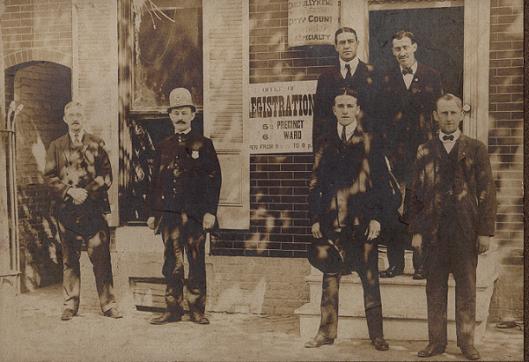
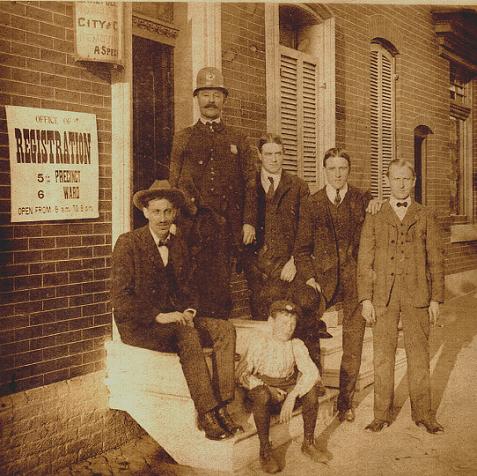



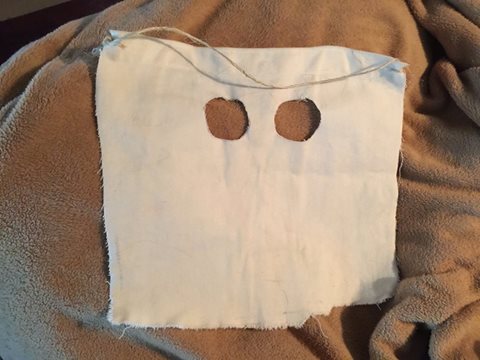 Mask
MaskSleuths Have Mask System
The Sun (1837-1989); Jul 29, 1908; pg. 12
The first prisoner subjected to ordeal turned pale
The mask system, which enables detectives to examine Crooks without being recognized, was inaugurated yesterday 28 July 1908 by the detective department. The masks worn by the detectives were of the ordinary white dominoes, with Muslin covering the lower part of their faces. They are adjusted by the elastic band, which is slipped over the back of the head.
The prisoner put under the eyes of the 20 detectives was Hyman Movitz, 18 years old, who is charged with being a pickpocket. He was placed on a platform in the assembly room of the courthouse by Capt. of detectives Pumphrey, who was not masked, who told the detectives who the man was and what he was charged with. “I want you men to examine this youth closely,” he said.
The 20 detectives scrutinized the youth. The latter group pale and seized the brass railing under the ordeal. During the examination Col. Sherlock Swann, president of the police board, stood by and took in the proceedings with interest. Col. Swan brought the idea from New York, where he went last spring to familiarize himself with the methods adopted by the police of that city. He was greatly impressed by the scheme, believing it an excellent means of having detectives identify prisoners or suspects without themselves being scrutinized. Moritz, who face the detectives yesterday, was arrested Monday night by patrolman Wulfert, of the central district, on the charge of picking the pocket of Adolph Ettner, 1500 North Chapel St., and stealing seven dollars. He was committed for court by justice Grannan, of the Central District.

Baltimore's Subtle Sleuths Now Wear Masks
2 Aug 1908
A mysterious looking mask now Baltimore detective. They are used forms part of the equipment of everyday morning inspection when all the burglars, murderers, bunco-steerers, highwaymen and other desperate criminals bad during the night are trotted out for the sleuth’s inspection. In a dimly lit room, the detectives gather each with his face covered by his mask. Then the door opens, and a trembling felon, with gyves upon his wrists, is brought forth from the dungeon beneath the courthouse. The felon mounts a platform and 20 pairs of eager eyes drink in every detail of his visage. “This,” says Capt. Pumphrey, “is William Smith, alias Billy the bunk, alias horrible Harold, alias the blood tubs. He has served 20 years in Moyamensing for murder, 20 in Moundsville for Rob ring a post office, 23 and Juliet for arson, 30 in Sing Sing for piracy on the high seas, and 10 days in Baltimore city jail first spit in a streetcar. Feast your eyes, gents, upon his malevolent features. Pipe his evil eyes. See his sloping brow. He is a harsh, desperate man. Remember him.” And then William is dropped back into his dungeon and another crook is brought forth. Each is subjected to the close scrutiny of every sleuth in the office. By this means the detectives make themselves familiar with the faces of all of the most eminent criminals, while the criminals, in turn, have no chance to make notes of the facial peculiarities of the detectives.

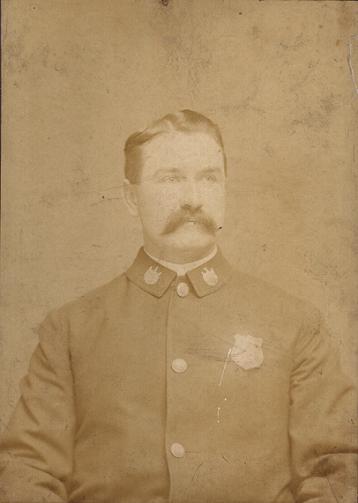



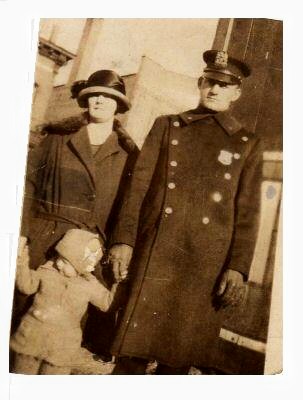

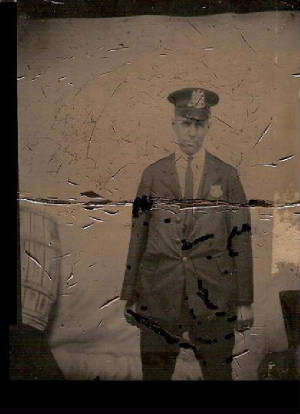

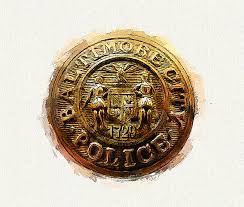

1 Oct 1942
Brass Buttons Taboo, Policemen's Future Dark
The Evening Sun 1 Oct 1942 page 27 and page 44
Officers Face World Grimly as WPB [War Production Board] Order takes Twinkling Coat easterners From New uniform Coats.
The Baltimore Police Department found itself in a hole today - a BUTTONHOLE… The fortunes of war "shot" the tradition brass buttons right off the uniform of the Bluecoats. Boy, are the police glad their pants buttons are black! A button manufacturer in Waterbury, Connecticut, informed uniform makers here that no more brass buttons will be available for police uniforms, and the uniform manufactures notified Commissioner Robert F. Stanton, who in turn notified Senator George R. Radcliffe.
Could Wear Overalls
Senator Radcliffe tendered his deepest buttons - beg pardon, sympathies - but said there was nothing he could do to help the police department out of its hole. The restriction on the manufacture of brass buttons is a War Production Board order which became effective 4 Sept 1942, he said. The order prohibits the use of brass buttons for anything except overalls or dungarees, which, if you ask the bluecoat on the beat, sounds a little bit like rubbing it in.
What! No Pants?
The next class of probationary policemen to be graduated from the police school will be the first members of the department to feel the pinch of the button crisis. But the last class, numbering 30, which was graduated yesterday, had a hint of the hard times ahead. They had to graduate without their pants, that is. The graduation took place in the Police Building on the Fallsway. The graduates had coats, caps, white shirts and black ties, but no pants - uniform pants. Furthermore, they can't go on the street duty until they get pants - uniform pants.
Stanton is Perplexed




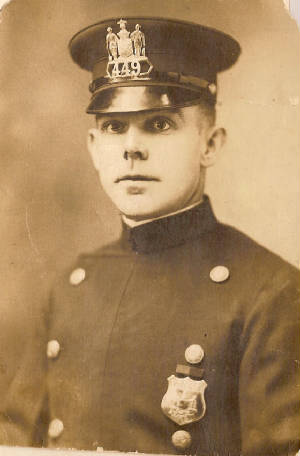
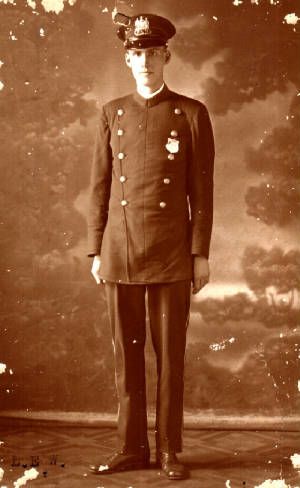

Officer Harry Koffenberger,
His son, also named Harry Koffenberger retired as a Major. Grandfather of Chief Ken McLaughlin, Ocean View, Delaware Police Department and Officer Timothy P. McLaughlin, and Michael Koffenberger both of the Baltimore County Police Department, Cockeysville Precinct and Franklin Station respectively. A true and dedicated Police Family.

Harry Koffenberger is a 24-year veteran of the Baltimore City Police Department, where he rose through the ranks to retire as a major and district commander of the department’s southeastern district, an area that includes Fells Point, Canton, Highland town and Little Italy. Starting as a beat police officer, he was promoted to sergeant and served with the helicopter service. Later, he advanced to the rank of lieutenant in the homicide division. One of the distinguishing characteristics of Koffenberger’s police career was his strong community involvement.
![]()
POLICE INFORMATION
Copies of: Your Baltimore Police Department Class Photo, Pictures of our Officers, Vehicles, Equipment, Newspaper Articles relating to our department and or officers, Old Departmental Newsletters, Lookouts, Wanted Posters, and or Brochures. Information on Deceased Officers and anything that may help Preserve the History and Proud Traditions of this agency. Please contact Retired Detective Kenny Driscoll.

NOTICE
How to Dispose of Old Police Items
Please contact Det. Ret. Kenny Driscoll if you have any pictures of you or your family members and wish them remembered here on this tribute site to Honor the fine men and women who have served with Honor and Distinction at the Baltimore Police Department. Anyone with information, photographs, memorabilia, or other "Baltimore City Police" items can contact Ret. Det. Kenny Driscoll at
Copyright © 2002 Baltimore City Police History - Ret Det Kenny Driscoll
